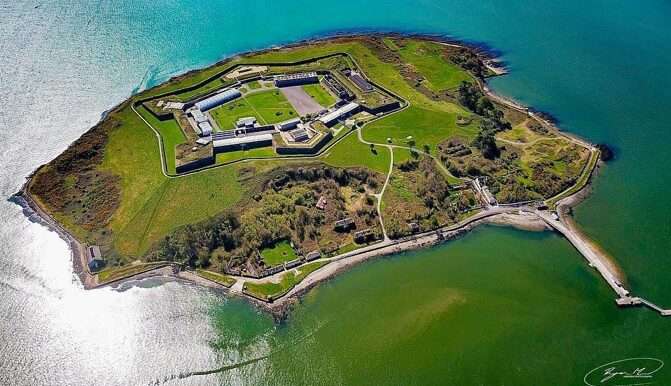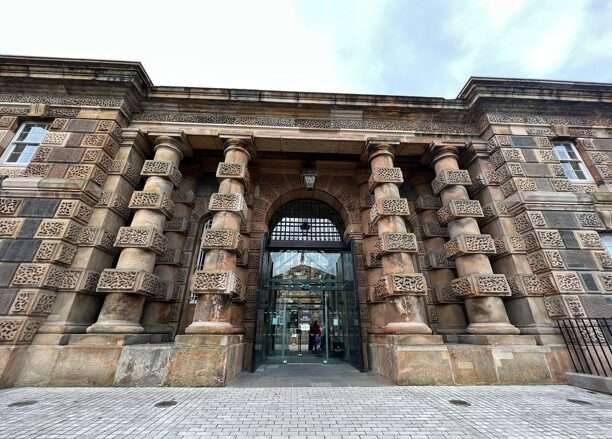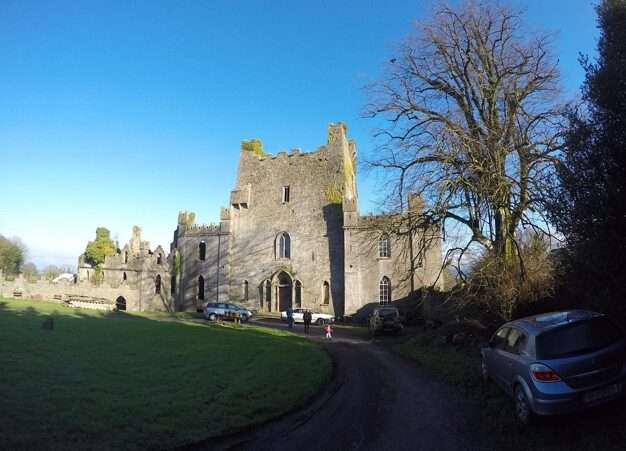- Home
- Blog
- Write for Us
- Travel Shop
- Type of TripsSolo Female TravelGirls Trip DestinationsAdventureBudget TravelLuxury TravelSolo Female TravelGirls Trip DestinationsAdventureBudget TravelLuxury Travel
- Resources

Picture this: you’re wandering through Ireland, a land known not just for its lush green landscapes and cheerful pubs but also for its deep, often sad history. This isn’t your typical sightseeing trip; it’s an exploration into the darker side of Ireland’s past. Welcome to the world of dark tourism, a niche but growing travel area where people visit sites associated with tragedy, death, and the macabre. As self-proclaimed experts with over five years in the field, we’ve explored countless dark tourism destinations around the globe. Today, we’re focusing on Ireland, a country with a rich history that’s as haunting as it is fascinating.
Nestled in Co. Cork, Spike Island’s past as a prison and fortress embodies it with an eerie resonance, making it a place where the echoes of Ireland’s struggles and rebellions are palpably felt. As you traverse this somber location, the heavy air of history weighs upon you, painting every corner with tales of despair and defiance.
The island’s dark and scary ambiance is accentuated by the bleak, stone walls of its prison cells, which stand as a stark reminder of the isolation and hardship faced by its inmates. This foreboding atmosphere is further enhanced at night when the shadows lengthen, and the whispers of the past seem to grow louder, enveloping the island in an almost tangible sense of dread and mystery. So, get ready for a very dark tour and prepare your mind for what was, as Spike Island reveals the chilling reality of its historical significance, cloaked in the darkness of its turbulent past.

2. Jeanie Johnston Tall Ship: A Famine Tale
Docked in Dublin, the Jeanie Johnston Tall Ship stands as a poignant monument to the Great Famine, painting a vivid picture of one of the most devastating periods in Irish history. As you step aboard, you’re transported back in time, imagining the thousands who fled starvation and despair, their hearts heavy with both the sorrow of leaving home and the fragile hope for a new beginning in America. The ship itself, meticulously preserved, makes the desperate journey of its passengers feel incredibly real.
Walking through its quarters, you can almost hear the whispers of their stories, filled with dreams and determination. The dark and somber tale it embodies is not just about the physical journey across the Atlantic, but also about the immense emotional toll it took on those seeking refuge from the famine’s grip.
The Jeanie Johnston serves as a somber reminder of the resilience of the human spirit in the face of unimaginable hardships, making their story of hope and survival resonate deeply with visitors.
3. Kilmainham Gaol: Freedom’s Pric
This old jail, Kilmainham Gaol, stands as a stark monument to Ireland’s tumultuous fight for independence in Dublin, its walls whispering the stories of both heroes and ordinary folk who faced harsh realities in their quest for freedom. The reason it feels all dark and scary isn’t just because of the physical confines—cold, damp cells and echoing corridors—but because of the deep, unsettling knowledge of the suffering endured within these walls. As you walk through Kilmainham Gaol, the oppressive atmosphere is palpable, with each cell telling its own tale of despair, resilience, and the high price of pursuing a cause.
The shadows seem to cling a little tighter here, filled with the echoes of those who were imprisoned, many of whom never left. The gaol’s history of execution and detainment during periods of rebellion adds a chilling layer to its legacy, making it a powerful, if eerie, place to comprehend the full weight of what the fight for freedom has cost. It’s a somber reflection on the sacrifices made in the shadows of these walls, where the fight for Irish independence took a dark and scary turn, leaving behind a legacy that is both inspiring and haunting.
4. Titanic Belfast: Tragedy at Sea
Standing in the very place where the Titanic was built, this museum in Northern Ireland encapsulates the ship’s tragic story, guiding visitors from its grand beginnings to its fateful end. The reason it all feels dark and scary isn’t solely due to the catastrophic loss of life but also because of the eerie juxtaposition of human achievement and hubris.
As you wander through the exhibitions, you’re immersed in the optimism and pride of those who built what was believed to be an unsinkable marvel, only to be confronted by the harrowing reality of its demise. The dark, immersive galleries, filled with personal stories, artifacts, and haunting underwater images of the wreck, create a palpable sense of dread and sorrow. The museum’s design itself, reminiscent of a ship’s hull, adds to the ominous atmosphere, enveloping visitors in the shadow of the Titanic’s legacy.
The chilling realization that this monumental tragedy unfolded from human error and natural forces makes the experience all the more somber. It’s a stark reminder of the fragility of life and the unforgiving power of the sea, making Titanic Belfast a profound, if somewhat scary, journey through history.
5. Crumlin Road Gaol: Belfast’s Historic Prison
 In Belfast, Crumlin Road Gaol serves as a stark reminder of The Troubles, encapsulating the somber history of Northern Ireland during one of its most turbulent periods. This former prison, now transformed into a museum, invites visitors to step into the chilling reality of life behind bars, where political prisoners and criminals alike were detained. The dark and scary ambiance of the gaol is palpable, with its cold, echoing corridors and cramped, bleak cells that seem to absorb the despair and tension of those who once inhabited them.
In Belfast, Crumlin Road Gaol serves as a stark reminder of The Troubles, encapsulating the somber history of Northern Ireland during one of its most turbulent periods. This former prison, now transformed into a museum, invites visitors to step into the chilling reality of life behind bars, where political prisoners and criminals alike were detained. The dark and scary ambiance of the gaol is palpable, with its cold, echoing corridors and cramped, bleak cells that seem to absorb the despair and tension of those who once inhabited them.
The haunting silence is occasionally broken by the echoes of footsteps, making it easy to imagine the ghosts of the past still lingering. The gaol’s history of executions, escapes, and the harsh realities of prison life during The Troubles adds a deeper layer of darkness to the experience. Walking through the same spaces where inmates lived and died, often under extreme conditions, one can’t help but feel a heavy sense of oppression and the weight of history.
The atmosphere is further intensified by stories of paranormal activity, with many visitors reporting unsettling experiences that suggest the past is still very much alive within the gaol’s walls. Crumlin Road Gaol’s eerie presence stands as a powerful testament to the scars of conflict, making it a haunting, yet invaluable, historical site.
6. Doagh Famine Village: Life in Harsh Times
In Co. Donegal, the Doagh Famine Village provides a stark, immersive glimpse into the grim reality of the Great Famine, allowing visitors to walk through preserved thatched cottages and experience the struggles and resilience of the Irish people during one of the darkest periods in their history. The reason it feels all dark and scary stems not just from the visual representation of poverty and despair, but also from the palpable atmosphere of suffering and loss that permeates the village. Each cottage tells a story of survival against the odds, with exhibits that detail the daily hardships faced by families, from starvation to disease and emigration.
The somber tone is accentuated by the haunting landscapes of Donegal, which frame the village in an almost desolate beauty, reminding visitors of the isolation and abandonment felt by those who lived through the famine. The chilling effect is further enhanced by personal accounts and historical records that bring to life the voices of the past, echoing their pain and hopelessness. This immersive experience not only educates but also deeply moves, making the Doagh Famine Village a solemn reminder of the harsh realities faced by generations, whose lives were irrevocably changed by a tragedy that shadows the land to this day.
7. Doolough Valley Memorial: A Tribute to Tragedy
In Co. Mayo, the Doolough Valley Memorial stands as a solemn testament to those who suffered and perished during the Great Famine, marking a site of haunting beauty and tragic history. The reason it feels all dark and scary is deeply rooted in the story it commemorates—a story of desperate famine victims forced to undertake a grueling march in harsh conditions, many of whom did not survive. This stark memorial, set against the backdrop of the rugged, desolate landscape of Doolough Valley, serves as a powerful reminder of the stark realities faced by those who lived through one of the darkest chapters in Irish history.
The chilling impact of the memorial is magnified by the silence and isolation of its surroundings, where the whispering winds seem to carry the echoes of the past, conjuring images of the weary, hungry souls who once passed this way. The natural beauty of the valley contrasts sharply with the somber history it holds, creating a poignant juxtaposition that underscores the tragedy with a profound sense of loss and mourning. As you stand before the memorial, the overwhelming sense of sorrow and the stark reminder of human suffering in the face of adversity envelops you, making the Doolough Valley Memorial a dark and scary, yet deeply moving, place of reflection and remembrance.
8. Leap Castle: Ireland’s Haunted Heritage
Leap Castle in Co. Offaly stands as a towering testament to Ireland’s haunted heritage, famous for its chilling ghost stories and an atmosphere dense with eerie energy. Its reputation as one of the most haunted castles in Ireland stems from a dark and violent history, marked by betrayal, murder, and unexplained phenomena, making it a place where legends feel unsettlingly real. The castle’s infamous Bloody Chapel and the pit in the dungeon, where prisoners were thrown and left to die, contribute to its terrifying allure.
Visitors often report strange occurrences, such as sudden drops in temperature, ghostly apparitions, and the feeling of being watched, heightening the sense of dread that permeates every stone. The castle’s storied past of family rivalries, hidden treasures, and ancient curses adds layers of mystery, inviting those who dare to explore its haunted halls.
As night falls, the castle’s foreboding silhouette against the darkening sky amplifies the sense of unease, making the experience of visiting Leap Castle all the more dark and scary. It’s not just the tales of the paranormal that unsettle the soul but the profound sense of history’s weight, where the line between the past and the present blurs, and the spirits of those long gone seem to linger in the shadows, waiting to tell their stories.

Beyond the Shadows: Understanding Ireland’s Painful Heritage
Ireland’s dark tourism isn’t just about spooky tales; it’s a deep dive into real human struggles.
The Great Famine and Beyond
The mid-19th century famine, caused by potato blight, was worsened by politics. It led to widespread hunger and forced many to leave their homeland. This sad part of history is remembered in places like the Jeanie Johnston ship.
Jails and Revolts
Kilmainham Gaol and Spike Island are more than old buildings. They’re symbols of Ireland’s long battle for its own voice, packed with stories of sacrifice and hope.
Ghosts and Legends
Then there’s Leap Castle, shrouded in ghostly legends and tragic tales. It’s a place where Ireland’s rich folklore feels alive, giving you a chill and a thrill.
The Layers of Dark Tourism
We see different layers and aspects of dark tourism in exploring these sites. Each site offers a unique perspective on Ireland’s history, blending educational value with emotional impact.
Education and Emotion
Sites like Kilmainham Gaol and Spike Island are powerful educational tools, helping visitors understand the historical context of Ireland’s fight for independence. At the same time, they evoke deep emotional responses, connecting us to the past profoundly.
Commemoration and Reflection
Memorials like the Doolough Valley Memorial are places of quiet reflection. They honor the memory of those who suffered and invite us to contemplate the impact of historical events on present-day society.
Thrills and Chills
Then, there are places like Leap Castle, where the thrill of exploring the paranormal meets the intrigue of historical legends. These sites cater to our fascination with the mysterious and the unexplained.
The Role of Dark Tourism in Modern Society
As we immerse ourselves in these sites, we begin to understand the role of dark tourism in our modern world. It’s not just about exploring grim or tragic sites; it’s about acknowledging and understanding the complex layers of history.
A Tool for Education and Awareness
Dark tourism educates people about parts of history that are often overlooked or forgotten. It highlights the struggles and sacrifices that have shaped nations and cultures.
An Avenue for Cultural Understanding
By visiting these sites, we gain a deeper appreciation for the culture and heritage of Ireland. We see how historical events have influenced the country’s identity and the resilience of its people.
A Catalyst for Personal Reflection
These sites also prompt personal reflection. They challenge us to think about our values, beliefs, and the human condition. They remind us of the importance of remembering the past to ensure a more compassionate and empathetic future.
FAQs:
What is Dark Tourism?
Answer: Dark tourism, sometimes known as ‘black’ or ‘grief’ tourism, involves visiting places known for their association with death, disaster, or atrocity. This could include sites of natural disasters, famous prisons, or locations of historical tragedies. The concept is not new; for centuries, people have been drawn to places of suffering, incarceration, and execution, either for education or macabre entertainment.
Why is Dark Tourism Controversial?
Answer: Dark tourism is often seen as controversial due to its focus on death and tragedy. Critics argue it can be disrespectful or insensitive to those who suffered. However, proponents see it as a way to remember and learn from past atrocities, fostering a deeper understanding of history and human nature. The ethical considerations vary widely based on how these sites are presented and interpreted.
What are Some Key Dark Tourism Sites in Ireland?
Answer: Ireland has several notable dark tourism sites, including Kilmainham Gaol and Glasnevin Cemetery in Dublin, Spike Island in Cork, and Crumlin Road Gaol in Belfast. These sites offer insights into Ireland’s history of rebellion, incarceration, and The Troubles, among other aspects of its sad past.
How Does Dark Tourism in Ireland Reflect Its History?
Answer: Dark tourism sites in Ireland reflect its complex and often tragic history, including periods of Famine, rebellion, and political strife. Visiting these sites provides a deeper understanding of the historical events that have shaped Ireland’s identity and offers a unique perspective on the nation’s cultural heritage.
What Motivates People to Engage in Dark Tourism?
Answer: People are drawn to dark tourism for various reasons, including a morbid curiosity about death and disaster, a desire for unique and emotional experiences, and a personal or historical connection to the site. For some, it’s about paying homage to victims. In contrast, for others, it’s an opportunity for education and reflection on the darker aspects of history and humanity.
Is There a Connection Between Dark Tourism and Ireland’s Cultural Attitude Toward Death?
Answer: Ireland’s history and culture have a notable focus on themes of death and suffering, influenced by its turbulent history of Famine, oppression, and conflict. This cultural aspect likely contributes to the interest in dark tourism, as it aligns with the nation’s historical narrative and collective memory.
Wrapping Up: Embracing the Shadows of the Past
In conclusion, dark tourism in Ireland is more than just a journey through eerie and somber sites. It’s an exploration into the heart of Irish history, culture, and identity. These sites, each with their haunting stories and lessons, offer a unique window into the soul of Ireland.
Our journey through Ireland’s dark tourism destinations has shown us the importance of preserving these sites. They are vital in keeping the stories of the past alive, ensuring that the lessons learned are not forgotten. As we leave these shores, we carry a deeper understanding of Ireland. This land has endured and triumphed over its dark history.
So, Ireland’s dark tourism sites are a must-visit for those seeking a different kind of travel experience, one that combines history, education, and emotional depth. They offer an unforgettable journey into a past that continues to shape the present and the future. No matter where you choose to visit, always remember to Travel Till You Drop!


Hi, Jill Here
Hi! I’m Jill, a Dallas, Texas girl traveling the world. After a career in the Air Force and touring over 50 countries later, my need to explore keeps going! It’s time to rock & roll and find all those places I never knew I was missing.
Join me to get exclusive travel tips, giveaways and more!
Gallery
Copyright © 2023 | All Right Reserved